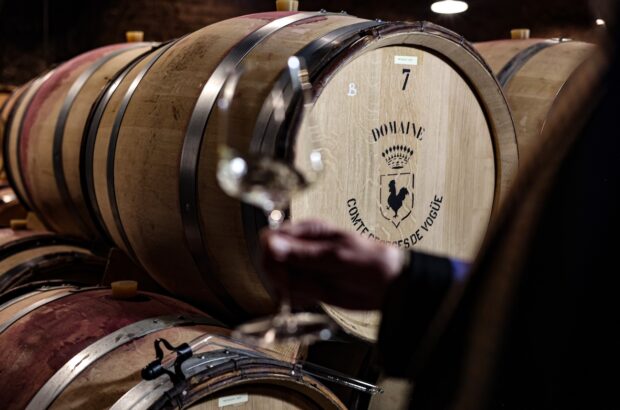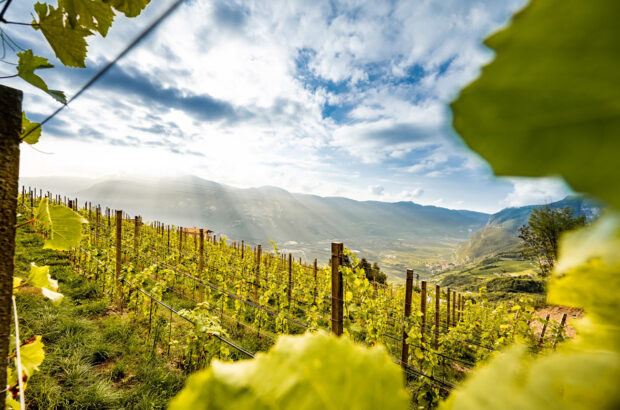Something is changing. The evidence is probably lying quietly in cellars around the world. Here, though, is a little homage to Catalonia, since that was where I recently saw it at first hand for myself.
View to Montserrat. Credit: Andrew Jefford
I was in Penedes to run a couple of tasting seminars for the Vilafranca-based ‘Wine Aspects’ programme – and that gave me the chance to dosome local tasting. Four visits and, as much by coincidence as design, each winery turned out to grow its fruit in either an organic or a biodynamic manner.
Not only that, but three of them were making either natural wines or amphora wines, or both – not loudly or exclusively, but simply as part of a range where quality and terroir expression was the goal. No one gave me an ideological rant, or tried to pass off deviance as purity; indeed they all insisted on cleanliness and freshness as an ideal. ‘It’s very important to us that we don’t have to make excuses or explanations for our natural wines,’ said Jordi Fernandez Davi of Pares Balta. ‘The comment we like most about them is “If you hadn’t told me, I wouldn’t have known.”‘
Maybe, these visits left me thinking, the viticultural future around the planet really could be organic; maybe, with enough attention to detail, it may be possible to produce quality wine – limpid wine with a clean, unoxidised and allusive profile, and not in any way cidery, murky and coarse – with no more than the 10 mg or so of sulphur which wine naturally produces infermentation.
There are no natural or amphora wines marketed by Castellroigas yet, but few Catalan producers are more obsessed with terroir – the soils in its 62 organically cultivated parcels have been minutely analysed, and all of its still and sparkling wine range – some sold under the Sabate i Coca label – is designed to showcase vineyard and indigenous varieties. The 2012 Sabate i Coca single-vineyard Xarel-lofrom Terroja shone: dry grasses, a summer wind, fennel fronds and limestone dust, all sketched out in a poised, weighty yet entirely oakless wine. It was hard, too, to forget the 2010 pure-Garnacha sparkling Sabate i Coca Cava Rose Reserva Familiar: dark, forceful, deep, tart, herbal. Especially since I tasted it at breakfast-time in the vineyards from which it came, gazing through the chill spring wind towards jagged Montserrat at the head of the valley, accompanied by the soft urgency of a male cuckoo’s call.
The previous afternoon I’d seen a rearing snake, fiercely determined to hang on to the dead baby rabbit in its mouth. It was Mireia Pujol-Busquet who spotted this ,as we toured her family’s vineyards in Alella to the north of Barcelona. The 2013 AA Bruel of Alta Alella (this will be called Bruand from 2014) was a pure Xarel-lo, known as Pansa Blanca up here: an outstanding natural sparkling wine which both smelled and tasted of wet rocksalt and more fennel with a little soft yet pristine apple in the background. It’s bottled in recycled bottles, just as the new winery extension Alta Alella is building is made of recycled shipping reefer containers, shaded by graceful swan-wings of mesh – and neither, I have to say, looks remotely tatty.
(Why is it that sulphur-free sparkling wines seem to work more successfully in general than their still counterparts? The logical answer, I guess, is because they are awash with protective carbon dioxide — and so have less need of the sulphur in the first place.)
It wasn’t the wildlife which thrilled at Pares Balta so much as the archaeology. A pit in which amphorae were fired some 2,300 years ago has been unearthed in some of the forest land owned by the Cusine family which runs Pares Balta; we gazed at it in unfeigned reverence as the Catalan sunshine coaxed the pines into scent around us. ‘Two years ago we had no idea that this was here,’ remembered Jordi Fernandez Davi. ‘When we found this pit it was like a message. We said “We have to try making wine in these again.”‘ The team then discovered that a vein of clay a short distance away in the forest was perfect for making amphorae; perhaps that was why the kiln had been there in the first place.
To craft wine in a vessel made from your own clay perfectly suits the Pares Balta biodynamic philosophy; this is one of those rare BD domains which makes all its own preparations, including from the horsetail which grows wild on the property. The Pares Baltawines I tasted with Jordi were limpid and expressive, too, notably the single-vineyard 2012 Electio Xarel-lo produced from 90 year old vines (liquified dust, silence and sunlight) and the 2012 Hisenda Miret Garnacha (light, brisk, fresh, pert, taut). The 2014 sulphur-free Amphora Xarel-lo is a little less successful; not deviant, certainly, but method – those tell-tale wheat-beer notes – still has the upper hand over variety and place in its sensorial profile. In this case I think I would have known, but I look forward to future versions.
And then… there is Sicus, the domain of a remarkably single-minded young wine craftsman called Eduard Pie Palomar. He works in the previously unheralded village of Bonastre in Lower Penedes, where he was born, using five little patches of vineyard next to the wild hills. His vineyards, I have to say, smelled exquisite in the spring air – sweet limey soils aromatically brocaded by the carpet of wild flowers and hay grasses. He, too, uses indigenous varieties alone, organically grown and amphora-fermented in vessels of local clay, some of which are actually buried in the vineyards themselves (Sicus Sons) and some of which ferment in the winery (Sicus).
I loved the poetry of his project: Pie Palomar’s idea was that the wine should be ‘inspired’ and informed by their environment to the maximum extent, evolving in the same earth in which the vines pass their lives, accompanied by the same birdsong… though the process is laborious, expecially for the red Garrut (Monastrell or Mourvèdre), which needs daily pigeage as duskfalls over the autumn hills. Emptying the amphorae is also arduous. Exquisite moments compensate: the wines clarified in the snow this year.
His are fine wines, beautifully labelled – he uses some sulphur, and is constantly on guard against oxidation. His now-mature 2009 Sicus Cru Mari sparkling Xarel-lo, called Cartuxa locally, was masterful and smelled, almost miraculously, of the meadow hay filling the vineyards; its breadth, structure and aromatic poise were thrilling. The 2013 Sicus Sons Xarel-lo, vineyard-fermented, was bloomy, broad and wealthy. Comparing the two 2013 Monastrells was a treat: the cellar-fermented Sicus version had a cliff face of sheer raspberry fruit, while the vineyard-fermented Sons version was earthier and more planty, though barely less dramatic. (Original to the last, Pie-Palomar uses sulphur to block the malo in these reds – hence their almost coruscating grandeur.)
Would Pie-Palomar’s wines qualify as natural or not? I’ve no idea, nor does it matter. What they do is realise terroir with striking limpidity, drama and precision – via the poetry and the originality of his methods. That’s new.
Written by Andrew Jefford







